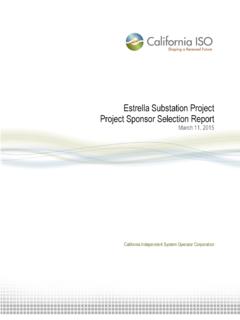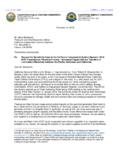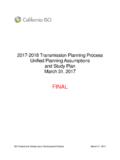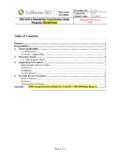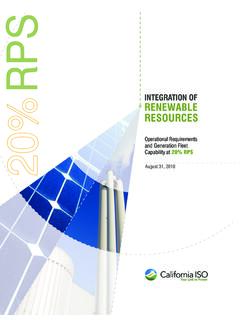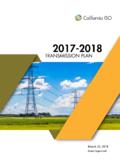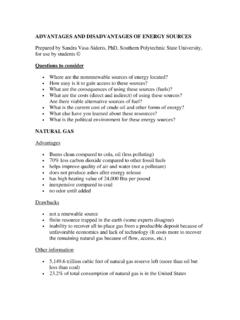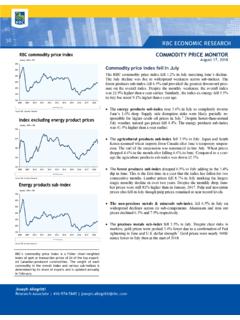Transcription of PacifiCorp-ISO Energy Imbalance Market Benefits
1 PacifiCorp-ISO Energy Imbalance Market Benefits March 13, 2013. 2013 Energy and Environmental Economics, Inc. P a g e |1|. PacifiCorp-CAISO Energy Imbalance Market Benefits 2013 Copyright. All Rights Reserved. Energy and Environmental Economics, Inc. 101 Montgomery Street, Suite 1600. San Francisco, CA 94104. P a g e |2|. Table of Contents Executive 1 Introduction .. 10. Background and 10. Structure of this Report .. 11. 2 EIM Analysis .. 12. Key Assumptions .. 12. What is an EIM and what would it do? .. 12. EIM 13. Key modeling assumptions .. 15. 22. Interregional dispatch savings .. 22. Intraregional dispatch savings .. 23. Reduced flexibility reserves .. 25. Reduced renewable Energy curtailment .. 27. EIM Scenarios .. 29. EIM Benefits .. 31. Attribution of EIM Benefits .
2 33. 3 Interpreting the Results .. 36. Conservative Nature of the 36. Comparison to other Studies .. 38. Attachment: Technical Appendix 2013 Energy and Environmental Economics, Inc. P a g e |3|. PacifiCorp-CAISO Energy Imbalance Market Benefits Executive Summary This report examines the Benefits of an Energy Imbalance Market (EIM) between PacifiCorp and the California Independent System Operator (ISO). This report focuses on estimated potential EIM Benefits with the low range reflecting a scenario in which assumptions were chosen to be conservative. The full range of estimated EIM Benefits in this report for the year 2017 is $21 million to $129 million (2012$). Preliminary cost estimates (based on previous studies) of setting up the EIM range from $3 million to $6. million, with an estimated annual cost of $2 million to $5 million.
3 The report supports the conclusion that the two-party EIM provides a low-cost, low-risk means of achieving operational savings for both PacifiCorp and ISO and enabling greater penetration of variable Energy resources. The report further supports that the Benefits of the EIM would increase to the extent that: (1) operational changes can be made to support the EIM, such as increased transmission transfer capabilities between PacifiCorp and ISO; and (2) additional entities join the EIM, thus bringing incremental load and resource diversity, transfer capability, and flexible generation resources that would further reduce costs for customers. P a g e |4|. Changes in the electricity industry in the Western are making the need for greater coordination among balancing authorities (BAs), 1 such as through an EIM, increasingly apparent.
4 Renewable portfolio standards already enacted in Western states are expected to result in some 60,000 MW of wind, solar, geothermal, and other renewable generation in the Western Interconnection by 2022, comprising approximately 15% of total electric Energy . 2. Recent studies have suggested that it will be possible to reliably operate the current western electric grid with high levels of variable generation, but doing so may require supplementing the hourly bilateral markets used in the West toward shorter scheduling timescales and greater coordination among western BAs. Greater coordination would allow BAs to pool load, wind, and solar variability and reduce flexibility reserve requirements, and would increase flexibility and reduce renewable curtailment. In response, several regional initiatives, studies, and groups have emerged to explore innovations for scheduling and coordination.
5 These include reforms being assessed as part of the Western Electric Coordinating Council's Efficient Dispatch Toolkit (EDT). initiative, an effort by a group of public utility commissions to explore an EIM for the West, and an ongoing Northwest Power Pool initiative to analyze the Benefits of an EIM. or other forms of regional coordination for the Pacific Northwest region. As an extension of these efforts, in February 2013 PacifiCorp and ISO signed a memorandum of understanding to pursue an EIM. Energy and Environmental Economics, 1. A balancing authority (BA) is a responsible entity that integrates resource plans ahead of time, maintains load-interchange- generation balance within a balancing authority area, and supports Interconnection frequency in real time. A balancing authority area (BAA) is the collection of generation, transmission, and loads within the metered boundaries of a balancing authority, which maintains load-resource balance within this area.
6 2. These renewable capacity and Energy projections are from the Western Electricity Coordinating Council's Transmission Expansion Planning Policy Committee (TEPPC) 2022 Common Case; see 20 Common%20 Case%20-%20 Webinar% 2013 Energy and Environmental Economics, Inc. P a g e |5|. PacifiCorp-CAISO Energy Imbalance Market Benefits Inc. (E3), a consulting firm, was retained by ISO to assess the EIM's potential Benefits . This report documents E3's findings. The EIM under consideration is a balancing Market that optimizes generator dispatch within and between balance authority areas (BAA) 3 every five minutes by leveraging the existing ISO real-time dispatch Market functionality. It does not replace the day-ahead or hourly markets and scheduling procedures that exist today. The ISO outlined the structure of such an EIM in a recent proposal to the Western Governors Association and the Public Utilities Commissions Energy Imbalance Market (PUC-EIM) Task Force.
7 4. An EIM covering PacifiCorp and ISO would allow both parties to improve dispatch efficiency and take advantage of the diversity in loads and generation resources between the two systems, reducing production costs, operating reserve requirements, and renewable generation curtailment. Specifically, the creation of a PacifiCorp-ISO EIM. would yield the following four principal Benefits : Interregional dispatch savings, by realizing the efficiency of combined 5-minute dispatch, which would reduce transactional friction ( , transmission charges) and alleviate structural impediments currently preventing trade between the two systems;. Intraregional dispatch savings, by enabling PacifiCorp generators to be dispatched more efficiently through the ISO's automated system (nodal dispatch software), including Benefits from more efficient transmission utilization.
8 3. See footnote #1. 4. See CAISO, CAISO Response to Request from PUC-EIM Task Force, March 29, 2012, ; CAISO, Energy Imbalance Protocols (Revised to Support CAISO Cost Estimate for PUC-EIM) , January 24, 2013, P a g e |6|. Reduced flexibility reserves, by aggregating the two systems' load, wind, and solar variability and forecast errors; and Reduced renewable Energy curtailment, by allowing BAs to export or reduce imports of renewable generation when it would otherwise need to be curtailed. These Benefits are indicative but not exhaustive. A recent report by staff to the Federal Energy Regulatory Commission identifies non-quantified reliability Benefits that will also arise. These include enhanced situational awareness, security constrained dispatch, faster delivery of replacement generation after the end of contingency reserve sharing assistance, and enhanced integration of renewable resources.
9 5. E3 estimated Benefits from a PacifiCorp-ISO EIM using the GridView 6 production simulation software to simulate operations of the Western Interconnection with and without the EIM in the year 2017. This year was selected to represent likely system conditions within the first several years after the EIM becomes operational. E3's analysis incorporated California's greenhouse gas regulations, and the associated dispatch costs. The GridView results are sensitive to several key assumptions and modeling parameters. These include: limits on the transmission transfer capabilities between PacifiCorp and ISO, and the extent to which unloaded hydroelectric capacity is allowed to contribute toward contingency and flexibility reserve requirements. E3's analysis of EIM Benefits is also sensitive to the assumed level of savings from moving to nodal dispatch in PacifiCorp and the amount of renewable Energy curtailment that could be reduced through the EIM.
10 5. Staff of the Federal Energy Regulatory Commission, 2013, Qualitative Assessment of Potential Reliability Benefits from a Western Energy Imbalance Market , February 26. 6. GridView is ABB's production simulation software. 2013 Energy and Environmental Economics, Inc. P a g e |7|. PacifiCorp-CAISO Energy Imbalance Market Benefits E3 developed several scenarios to address key uncertainties in the modeling of EIM. Benefits . These scenarios explore a wide range of potential benefit levels to reflect both the limitations of existing tools to characterize all of the changes to system operations that would occur under an EIM, particularly in the modeling of hydropower, reserves, and renewable curtailment, greenhouse gas regulation, and uncertainties about the extent to which future industry developments would allow cost savings to occur both with and without an EIM.


